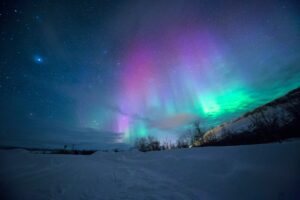 The celestial dance of lights known as the Aurora Borealis, or the Northern Lights, captivates the imagination and lures avid sky gazers into a world of cosmic wonder. In this brief journey, we’ll unravel the enigma surrounding this awe-inspiring natural phenomenon, exploring its definition, prime locations for viewing, the science behind it, and the role of the Sun’s cycle in orchestrating this breathtaking spectacle. For those seeking intimate encounters with the Aurora Borealis, small group travel and adventure tours to Iceland during the peak of the solar cycle offer a front-row seat to this mesmerizing display.
The celestial dance of lights known as the Aurora Borealis, or the Northern Lights, captivates the imagination and lures avid sky gazers into a world of cosmic wonder. In this brief journey, we’ll unravel the enigma surrounding this awe-inspiring natural phenomenon, exploring its definition, prime locations for viewing, the science behind it, and the role of the Sun’s cycle in orchestrating this breathtaking spectacle. For those seeking intimate encounters with the Aurora Borealis, small group travel and adventure tours to Iceland during the peak of the solar cycle offer a front-row seat to this mesmerizing display.
The Aurora Borealis, named after the Roman goddess of dawn (Aurora) and the Greek name for the north wind (Boreas), is a celestial light show caused by the interaction between charged particles from the sun and the Earth’s magnetic field. The result? A dazzling display of vibrant colors illuminating the polar night. Venture on adventure tours to the Arctic Circle for an up-close encounter with this breathtaking natural wonder.
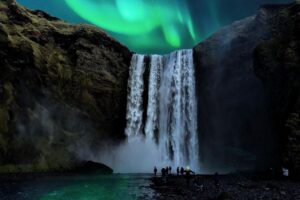
The activity of the Aurora Borealis is intricately linked to the Sun’s cycle, specifically the solar cycle. The Sun undergoes approximately an 11-year cycle of varying solar activity, marked by changes in sunspots and solar flares. During periods of heightened solar activity, the chances of witnessing a spectacular Aurora Borealis display increase significantly. Scientists predict that 2024 will mark the peak of the solar cycle, offering sky gazers an unparalleled opportunity to witness the Northern Lights in their full glory. To maximize your chances of experiencing this cosmic spectacle on small group adventure travel, plan your visit to coincide with the peak of the solar cycle, ensuring a mesmerizing display of lights against the Arctic backdrop.
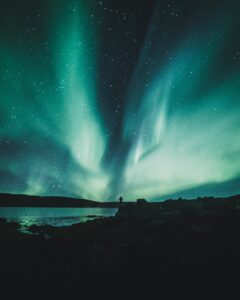
To witness this ethereal display, one must venture to high-latitude regions near the Arctic Circle, including destinations like Norway, Sweden, Finland, and Iceland. The Aurora Borealis graces the night sky primarily during the winter months, with peak visibility during the equinoxes. The darkness of the polar night enhances the visibility of the lights, creating a magical ambiance. Embark on small group adventure tours to Iceland for an immersive experience beneath the celestial curtain.
The science behind the Aurora Borealis is rooted in the sun’s activity. Solar winds carry charged particles, predominantly electrons and protons, toward Earth. As these charged particles collide with gasses in the Earth’s atmosphere, such as oxygen and nitrogen, they release energy in the form of light. The distinctive colors – greens, reds, and purples – depend on the type of gas particles and their altitude in the atmosphere.
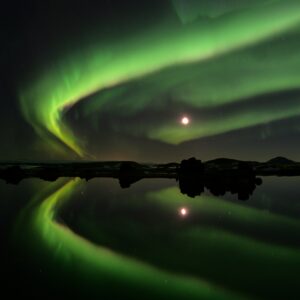
As you ponder the secrets of the Aurora Borealis, imagine standing beneath the celestial curtain, watching as colors dance across the northern sky. Pic
ture yourself in a serene landscape, surrounded by snow-covered trees and the soft glow of the lights above. The allure of the Aurora Borealis lies not just in its scientific marvel but in the experience of being part of a cosmic performance. For those seeking adventure tours to the Arctic, the Northern Lights add an extra layer of magic to the journey.
The Aurora Borealis invites us to look beyond the mundane, to gaze upward and embrace the cosmic artistry that graces our night sky. Venture on our small group travel and adventure tours to witness the dance of lights, and let the Aurora Borealis spark a lifelong fascination with the wonders of our universe.
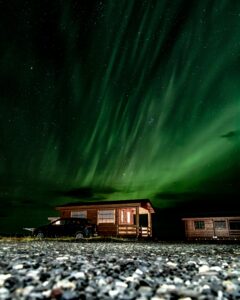
This brief exploration, enriched by the influence of the Sun’s cycle, merely scratches the surface of the Aurora Borealis’ mesmerizing tale. If you find yourself yearning for more, t
he night sky awaits, ready to unveil its celestial masterpiece.
Interested in joining us on a trip to Iceland to see the Aurora? Drop us a note at info@biotrekadventuretravels.com today.
By Tiffany Dallman







